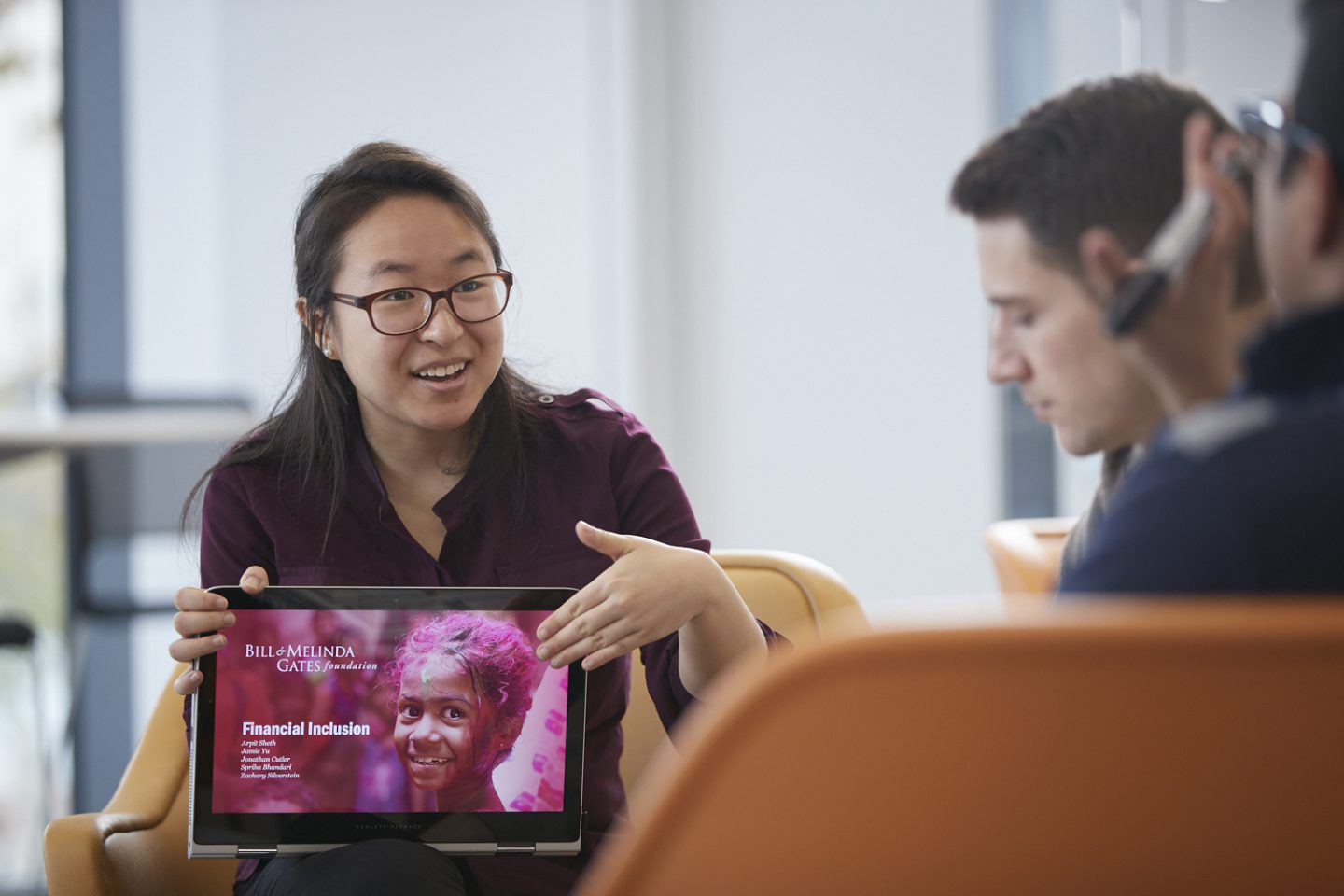Cornell Tech Students Lead the Way in Building Technology with Real-life Impact
Categories

Cornell Tech is built on an ethos of forging dynamic links between technology and society. This is seen in action each year in Product Studio, an intensive process during in which masters students from all seven programs collaborate to develop products in response to real-life challenges set by high-profile organizations.
Here are just two projects aiming to make real-life impact from Product Studio:
Turning People into ATMs
This year, the Bill & Melinda Gates Foundation posed a challenge: look at how we might ensure that low-income people who live in rural areas in emerging markets have an easy, affordable and trusted way to transform their money from physical to digital and back.
Graduate student Spriha Bhandari, Master of Laws ’18, explains that her team focused on a marketplace of 885 million people living in rural India who, due to a lack of easily accessible ATMs, cannot get money in and out of their bank accounts. Originally from India, Bhandari was able to bring invaluable insight and connections to the team.
“The people we were trying to target in the first place were people in villages, people who don’t have access to the banking infrastructure that we have access to in the cities or in countries like the US,” she says.
Tackling the challenge alongside Bhandari were fellow team members Zachary Silverstein, MBA ’18, Jonathan Cutler, CS Masters ’18, Arpit Sheth, CS Masters ’18, and Jamie Yu, Connective Media ’19.
For many rural Indians, exclusion from the digital economy extends beyond depositing and withdrawing money, says Silverstein. “They can’t have savings, they can’t build credit, they can’t borrow money, so how do you build incentives for these people?”
The team found that while their target market was disadvantaged in terms of banking infrastructure, they did have access to mobile phones and cash. The team capitalized on this while developing their product, Pocket Change — a chatbot application accessed via messaging platforms such as Skype and Facebook Messenger.
“The idea was to match people who wanted to deposit money with people who wanted to withdraw money, to make this Uber-like transaction between people in a community that didn’t actually have an ATM infrastructure,” explains Cutler.
Users scan banknotes into their phones, and the amount and serial number are verified using Google Vision. The chatbot then connects a user who wants to deposit cash with one who wants to withdraw, based on the amount requested, proximity, and trust rating. Users then meet in a safe, public space to carry out the real-life transaction.
Development challenges included security and legal issues, which the team addressed by implementing a user rating system. “We tried to focus on aspects of security, reliability, reputation, and rating to make the idea feasible for real people,” says Cutler.
After considering a range of options, the team opted for the chatbot model because it offered a cost-effective solution that would appeal to users who may not be accustomed to using digital products, “Someone who’s technologically illiterate and wants to feel safe and secure, would feel better talking to someone,” explains Cutler. Using tools such as voice and text recognition, a bot can be “fully conversational”, he says.
Connecting Data Scientists with Non-profits
Using tech to establish real-life connections also formed the basis of the challenge posed by Domino Data Lab, who asked: How might we create a marketplace that matches data scientists looking to solve a meaningful challenge with non-profit organizations in need of data-science help?
This question struck a chord with team members Joseph Gelber, MBA ’18, Kripa Agarwal, CS Masters ’18, Eyvind Niklasson, CS Masters ’18, and Daniel Kim, MBA ’18, several of whom had firsthand experience of the difficulties involved in finding volunteer work to match their skills.
“When I was working in Singapore, I wanted to volunteer for a non-profit, but I really didn’t know where to go or where to search,” explains Agarwal. “I wanted to use my technical skills for a social cause and this [challenge] was doing that; it was connecting volunteers to non-profits.”
So, why might non-profits want to connect to data scientists? Gelber cites the example of Thorn, a non-profit that works to stop child sex abuse. By analyzing data “to find out where this stuff is happening,” data scientists help Thorn take preventative rather than reactive action, he says.
The team found that a key issue faced by non-profits is that while they may have large amounts of data, it tends to be disorganized, says Kim. “They did not have the resources, money or talent to tackle what they want to solve; I think that was a challenge but at the same time that validated what we’re trying to do.”
The team established connections with the two user groups to build their solution, a web-based collaborative platform called Data for Everyone, explains Agarwal, “We shortlisted data scientists who have some work experience and non-profits who could afford to hire data scientists, so our project was creating a platform that could establish a good link between them.”
Gelber adds that their solution stands out from current competitors because it both creates an online marketplace and solves the problem of location, “Right now, if you connected a data scientist with non-profits, you have to actually physically be in the same location to collaborate.” This product solves that problem by both connecting the two groups and allowing work and discussion to take place online. This means that users can be anywhere in the world and collaborate.
Both teams impressed company representatives with their products, and conversations are ongoing as to how they might be implemented on the ground.
Media Highlights
Tech Policy Press
Content Moderation, Encryption, and the LawRELATED STORIES





